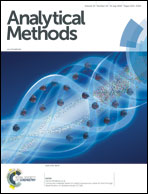Gold nanocone arrays directly grown on nickel foam for improved SERS detection of aromatic dyes†
Abstract
An efficient SERS substrate composed of gold nanocone arrays with abundant sharp tips directly grown on 3D porous Ni foam (AuNCA@Ni foam) was developed for sensitive detection of aromatic dyes. The AuNCA@Ni foam was prepared by a facile galvanic replacement reaction between Ni foam and HAuCl4 in the presence of cetyltrimethylammonium bromide (CTAB). The concentration of CTAB played an important role in determining the morphology of the product. Without CTAB or replacing CTAB with other surfactants, no AuNCA could be obtained. Thanks to the abundant uniform sharp tips and 3D porous structure, the AuNCA@Ni foam displayed much stronger SERS enhancement ability and higher reproducibility for aromatic dye detection compared with substrates prepared in the absence of CTAB or in the presence of other surfactants. Moreover, the AuNCA@Ni foam with the robust integrated structure also avoided the tedious operation of assembly and centrifugation. The SERS application of the AuNCA@Ni foam was tested by the detection of aromatic dyes crystal violet (CV) and Nile blue (NB), which achieved a detection limit (LOD) of 0.03 nM and 0.5 nM in standard solution, respectively, and an LOD of 3 nM for determining CV in real water samples.



 Please wait while we load your content...
Please wait while we load your content...